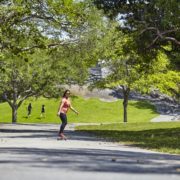The Value of Parks
The iconic components of most major cities are found in their parks. Central Park in New York, Chicago’s Millennium Park, Boston Manor Park in Boston and San Francisco’s Golden State Park, to name a few. What these cities knew early on was that not only do these parks transform their city’s skyline, but they also provide real value and a return on investment.
The measurable economic value of a city with a well-designed and well-maintained network of city parks is reflected in the strength of its economy, the condition of its environment and the health of its residents and communities.
In short, parks build better cities – making them sustainable, liveable and vibrant.
One of the most visible traits of an attractive and healthy city, and an essential component of its infrastructure, is a healthy park system that includes plenty of greenways, trails, blueways, open spaces and great streets. This type of park system spurs economic development by attracting homebuyers and boosting residential property values.
To help increase the County’s social, economic and environmental values and overall livability and visitor experience, Miami-Dade Parks created and is implementing the Open Space Master Plan. The plan creates a healthier, greener and more economically vibrant community, built on principles of equity, access, beauty, seamlessness, sustainability and multiple benefits.
Conservation and stewardship are an integral part of Miami-Dade Parks’ management practices. The department maintains 26,000 acres of natural areas including the Western Greenway and its conservation plan protects the fresh water of the Everglades and addresses adaptation to climate change. An expanding landscape of native trees and vegetation offers low cost and natural solutions to issues of rising sea levels, storm water runoff and air pollution. Successfully working to grow Miami’s inadequate tree canopy, more than 220,000 new trees have been planted since Neat Streets Miami first launched the Million Trees Miami campaign in 2011.
The health of a community begins with the health of its residents – no matter the age. Miami-Dade Parks together with long-time park partner, the University of Miami School of Medicine have evidence-based results for the improved health of underserved, at-risk youth participating in the Parks Department’s Fit2PlayTM program, touted as a low-cost, high-value solution and national model in fighting the childhood obesity epidemic. For the over 55 active adult population, the department utilizes the nationally recognized evidence-based EnhanceFitness® exercise program, designed to improve functional fitness and well-being. Through a combination of strength-training, flexibility and cardio-conditioning exercises – everything that health professionals say is needed to maintain health and function at any age – older adults have an opportunity to improve their overall health.
An integral component to sustaining natural areas, increasing value and improving the health and resiliency of residents and communities is making an investment in parks.
Isn’t it time we started?



